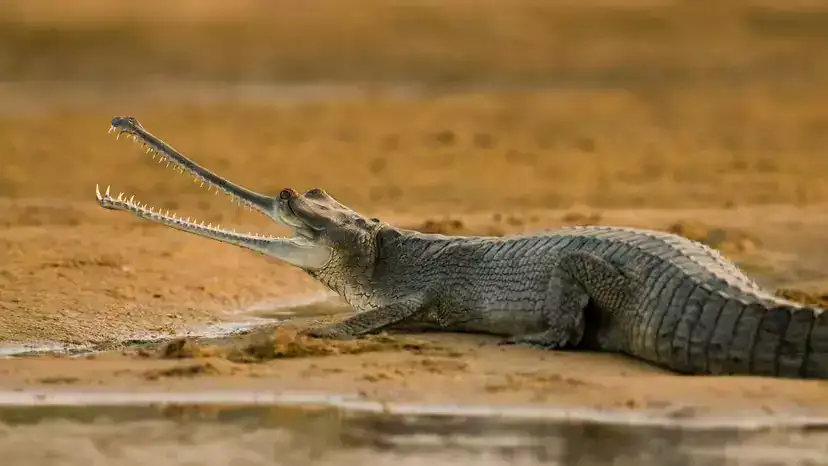Key Takeaways
Status: Critically Endangered (IUCN). Roughly 650 adult gharials remain in the wild; >75% live in National Chambal Sanctuary (North India).
Main threats: River sand mining, dams/flow alteration, gill-net entanglement; eggs are still taken for food/medicine in some areas.
Stand-out trait: An extremely long, slender snout specialized for fish. Adult males develop a hollow nasal knob (ghara) that amplifies buzzing calls.

Scientific name: Gavialis gangeticus
Common names: Gharial, gavial
Lifestyle: Strongly riverine; spends most time in water. Females nest on sandy riverbanks during the dry season.
Size: Adults typically 4–5 m (12–15 ft).
Feeding: Sweeps its needle-toothed, ultra-slender snout sideways through schools of fish.
Unlike broad-snouted crocodilians, gharials are highly piscivorous—the narrower the rostrum, the lower the drag and the quicker the lateral sweep.
Gharials show conspicuous sexual dimorphism. Upon maturity, males develop a hollow bulbous knob at the tip of the snout—the ghara (“clay pot” in Hindi).
Function: Amplifies acoustic signals (a buzz/boom) used in courtship, territorial and social displays.
Field ID: Quick way to distinguish adult males from females.
The false gharial (Tomistoma schlegelii) shares a narrow snout and fish diet, but differs in key ways:
Range: Tomistoma in Malaysia/Indonesia; gharial in India, Nepal, Bangladesh.
Color: False gharials are red-brown with dark blotches; gharials are green-gray and darken with age.
Threat level: False gharial = Vulnerable (several thousand mature); gharial = Critically Endangered (hundreds of adults).
Taxonomy: Close relatives, different genera.
Historic range: Formerly widespread across major South Asian rivers.
Stronghold today: National Chambal Sanctuary (India); smaller subpopulations in Nepal and a few other river systems.
Habitat needs: Medium–large rivers, moderate flows, and wide sandbars for basking, courting and nesting.
Sand mining
Removes/reshapes sandbars—the critical nesting substrate—and alters channel morphology.
Dams & flow regulation
Fragment habitats, disrupt seasonal water levels and shorten the effective nesting window.
Fisheries bycatch
Gill nets kill or injure juveniles and adults; drowning from entanglement is common.
Egg harvest
Adults are rarely hunted, but egg collection lowers recruitment.
Cumulative disturbance
Bank traffic, livestock trampling, boat traffic and tourism disrupt basking, mating and nesting.
Case in point: June 2023, an adult male gharial was found dead in a fishing net in Chitwan National Park, Nepal—proof that even large males are at risk.
Land & legal protection: Expand/strictly manage riverbank–sandbar core zones; apply seasonal closures around nesting.
Mining controls: License where/when/how much sand can be removed; enforce no-mining windows during nesting/hatching.
Fishery co-management:
Seasonal net restrictions/substitutions during courtship–incubation–hatching peaks.
Rapid response and training for net-cut/animal release; compensation and alternative livelihoods for local fishers.
Head-starting & release: Raise eggs/hatchlings in head-start centers, then release into low-disturbance reaches to boost early survival.
Monitoring:
Drones/thermal scans for sandbar surveys.
Camera traps/IR for basking and nesting chronologies.
Mark–recapture/PIT tags and mtDNA to estimate effective population size (Ne).
Outreach: School and fisher programs promoting gharial-friendly gear and no-approach rules at nests.
Why the ultra-slender snout? Lower drag and faster lateral sweeps—perfect for grabbing fast, slippery fish.
Basking matters: Thermoregulation drives daily/seasonal basking rhythms that align with maturity and nesting.
Juvenile bottlenecks: Flashy flows, nest flooding, trampling, net bycatch and food competition—key causes of early-life mortality.
How are gharials adapted for catching fish?
Their long, narrow rostrum and fine, interlocking teeth act like a comb, gripping slippery prey during rapid side-swipes.
What protects gharial habitats most effectively?
A mix of protected reaches, mining controls, seasonal fishery rules, community patrols/compensation, and head-start–release programs—backed by real-time monitoring.
animal tags: gharial
We created this article in conjunction with AI technology, then made sure it was fact-checked and edited by a Animals Top editor.